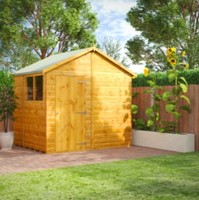A comprehensive guide to buying a garden shed

A garden shed is a valuable addition to any outdoor space, offering storage solutions and a dedicated area for various activities. Whether you need extra space for gardening tools, a workshop, or a place to store outdoor furniture, choosing the right garden shed is essential. In this guide, we will walk you through the important factors to consider when buying a garden shed to ensure that you make an informed decision.
1. Assess Your Needs
Begin by evaluating your requirements. Determine the purpose of the shed and what items you intend to store or activities you plan to carry out inside. Consider the size, style, and design features that will best suit your needs. Measure the available space in your garden to determine the appropriate shed dimensions.
2. Material Selection
Garden sheds are available in various materials, each with its own advantages and considerations. The most common options include:
a. Wood: Wooden sheds offer a classic and natural look. They blend well with garden aesthetics and can be painted or stained to match your preferences. However, they require regular maintenance to protect against rot and insects.
b. Metal: Metal sheds are durable, low-maintenance, and secure. They provide excellent resistance to pests, fire, and rot. However, they may be prone to rust and can be less aesthetically pleasing compared to other materials.
c. Plastic/Resin: Plastic or resin sheds are lightweight, affordable, and require minimal maintenance. They are resistant to rot, decay, and pests. However, they may have limited design options and can be less sturdy than wood or metal.
3. Consider Durability
Opt for a shed that can withstand the weather conditions in your area. Look for features such as reinforced corners, sturdy frames, and weather-resistant materials. Pay attention to factors like wind resistance, snow load capacity, and UV protection to ensure the shed can withstand the elements.
4. Security Features
If you plan to store valuable items in your shed, consider security features such as sturdy locks, reinforced doors, and windows with secure fittings. It's important to invest in a shed that will keep your belongings safe and provide peace of mind.
5. Ventilation and Lighting
Ensure that the shed has proper ventilation to prevent dampness and condensation. Look for sheds with vents or windows that can be opened to allow air circulation. Additionally, consider sheds with windows or skylights to provide natural light during the day, reducing the need for artificial lighting.
6. Assembly and Maintenance
Evaluate the assembly requirements of the shed before purchasing. Some sheds come with pre-cut and pre-drilled components for easier installation. Additionally, consider the maintenance needs of the shed material. Wood may require regular staining or painting, while metal and plastic sheds generally require minimal upkeep.
7. Budget Considerations
Determine your budget range before shopping for a garden shed. Prices can vary depending on the material, size, and additional features. Consider the long-term value and quality of the shed to make a worthwhile investment. It's important to strike a balance between your budget and the features you desire.
Choosing the right garden shed requires careful consideration of your needs, available space, budget, and desired features. By assessing your requirements, selecting a durable and secure material, and considering factors like ventilation and maintenance, you can find a shed that perfectly complements your outdoor space. Remember to research reputable manufacturers, read customer reviews, and compare different options to ensure you make an informed purchase. A well-chosen garden shed will not only provide practical storage solutions but also enhance the functionality and aesthetics of your garden.

